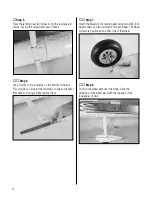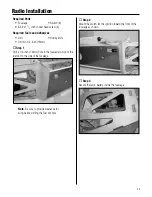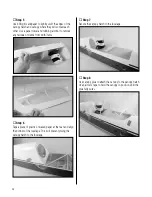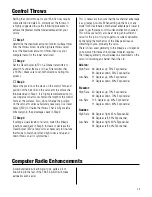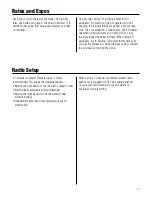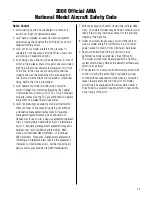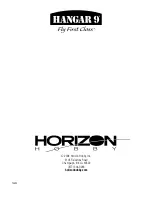
32
For those of you who are veterans of large models, this
is old news. But to you newcomers to the world of large
models, this is very important information.
Maintain the proper mechanical advantage on all
control surface linkages.
Just as with unsealed hinge gaps, mechanical advantage
is often another cause of flutter. Please follow the control
horn and servo arm lengths recommended in this manual.
Shorter arms on the servo or longer control horns on the
elevator and ailerons are fine, but do not try to go the
other way to increase throw. It can cause flutter or servo
failure on the YAK 54. The recommended linkage setups
are more than adequate to achieve full 3D throws.
Check the radio installation and make sure all the
control surfaces are moving correctly (i.e. the correct
direction and with the recommended throws). Test
run the engine and make sure it transitions smoothly
from idle to full throttle and back. Also ensure the
engine is tuned according to the manufacturer’s
instructions, and it will run consistently and constantly
at full throttle when adjusted.
Check all the control horns, servo horns, and clevises to
make sure they are secure and in good condition. Replace
any items that would be considered questionable. Failure
of any of these components in flight would mean the loss
of your aircraft.
While many smaller models are very tolerant of improper
control linkage setups and flying techniques, large models
are not. Don’t let that scare you away from large models;
they are truly one of the best flying experiences in RC that
money can buy. However, please pay particular attention to
the following areas.
Never attempt to make full throttle dives!
Large models perform much more like full-size aircraft
than small models. If the airframe goes too fast, such as
in a high throttle dive, it may fail. The YAK 54 should be
flown like a full-scale YAK 54. Throttle management is
absolutely necessary.
Hardware checks
Double-check the setscrews in all contol horns to be sure
they are very tight. Periodically check these to be sure
they have not loosened over time. Always use threadlock
on metal-to-metal fasteners.
Receiver Battery Selection
Be sure adequate batteries are used to power the receiver.
It is STRONGLY recommended that a 6-volt receiver pack
is used. It must have a minimun of 2700mAh capacity.
Servo selection
Be sure all servos used on elevator, aileron and rudder are
metal geared type and have at least 188 oz/in of torque.
Failure to do this will very likely result in a failure and
loss of the model.
Range check
Always range check the radio system per the
manufacturer's instructions before the initial test flight and
periodically afterward.
Check the voltage of the on-board packs
ALWAYS use an ESV with a 1-amp load to check the
receiver battery pack and the ignition pack before each
and every flight. If there is any doubt that the packs are
questionable, DO NOT FLY until the packs are recharged.
Preflight

